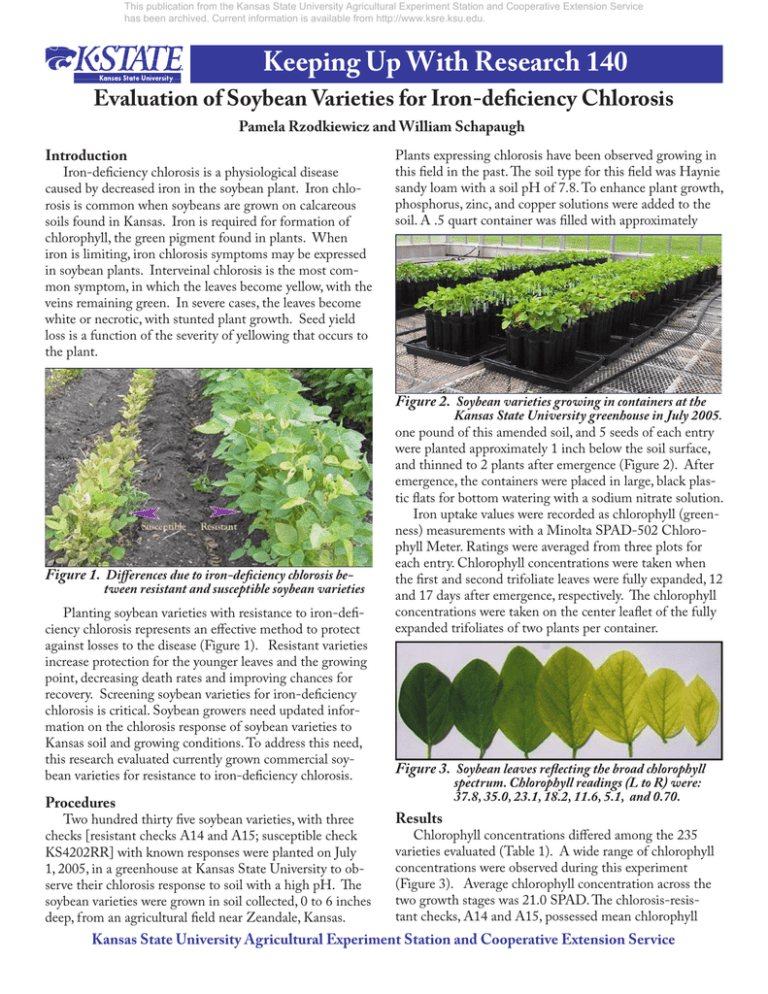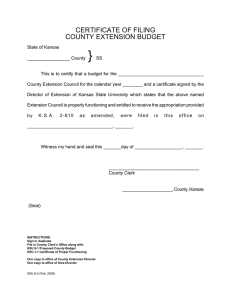
This publication from the Kansas State University Agricultural Experiment Station and Cooperative Extension Service
has been archived. Current information is available from http://www.ksre.ksu.edu.
Keeping Up With Research 140
Evaluation of Soybean Varieties for Iron-deficiency Chlorosis
Pamela Rzodkiewicz and William Schapaugh
Introduction
Iron-deficiency chlorosis is a physiological disease
caused by decreased iron in the soybean plant. Iron chlorosis is common when soybeans are grown on calcareous
soils found in Kansas. Iron is required for formation of
chlorophyll, the green pigment found in plants. When
iron is limiting, iron chlorosis symptoms may be expressed
in soybean plants. Interveinal chlorosis is the most common symptom, in which the leaves become yellow, with the
veins remaining green. In severe cases, the leaves become
white or necrotic, with stunted plant growth. Seed yield
loss is a function of the severity of yellowing that occurs to
the plant.
Plants expressing chlorosis have been observed growing in
this field in the past. The soil type for this field was Haynie
sandy loam with a soil pH of 7.8. To enhance plant growth,
phosphorus, zinc, and copper solutions were added to the
soil. A .5 quart container was filled with approximately
Figure 2. Soybean varieties growing in containers at the
Figure 1. Differences due to iron-deficiency chlorosis be-
tween resistant and susceptible soybean varieties
Planting soybean varieties with resistance to iron-deficiency chlorosis represents an effective method to protect
against losses to the disease (Figure 1). Resistant varieties
increase protection for the younger leaves and the growing
point, decreasing death rates and improving chances for
recovery. Screening soybean varieties for iron-deficiency
chlorosis is critical. Soybean growers need updated information on the chlorosis response of soybean varieties to
Kansas soil and growing conditions. To address this need,
this research evaluated currently grown commercial soybean varieties for resistance to iron-deficiency chlorosis.
Procedures
Two hundred thirty five soybean varieties, with three
checks [resistant checks A14 and A15; susceptible check
KS4202RR] with known responses were planted on July
1, 2005, in a greenhouse at Kansas State University to observe their chlorosis response to soil with a high pH. The
soybean varieties were grown in soil collected, 0 to 6 inches
deep, from an agricultural field near Zeandale, Kansas.
Kansas State University greenhouse in July 2005.
one pound of this amended soil, and 5 seeds of each entry
were planted approximately 1 inch below the soil surface,
and thinned to 2 plants after emergence (Figure 2). After
emergence, the containers were placed in large, black plastic flats for bottom watering with a sodium nitrate solution.
Iron uptake values were recorded as chlorophyll (greenness) measurements with a Minolta SPAD-502 Chlorophyll Meter. Ratings were averaged from three plots for
each entry. Chlorophyll concentrations were taken when
the first and second trifoliate leaves were fully expanded, 12
and 17 days after emergence, respectively. The chlorophyll
concentrations were taken on the center leaflet of the fully
expanded trifoliates of two plants per container.
Figure 3. Soybean leaves reflecting the broad chlorophyll
Results
spectrum. Chlorophyll readings (L to R) were:
37.8, 35.0, 23.1, 18.2, 11.6, 5.1, and 0.70.
Chlorophyll concentrations differed among the 235
varieties evaluated (Table 1). A wide range of chlorophyll
concentrations were observed during this experiment
(Figure 3). Average chlorophyll concentration across the
two growth stages was 21.0 SPAD. The chlorosis-resistant checks, A14 and A15, possessed mean chlorophyll
Kansas State University Agricultural Experiment Station and Cooperative Extension Service
This publication from the Kansas State University Agricultural Experiment Station and Cooperative Extension Service
has been archived. Current information is available from http://www.ksre.ksu.edu.
scores of 27.7 and 28.7, respectively. The score of 28.7 was
the highest average reading among the entries evaluated.
Germplasm lines A14 and A15 were released in 1987 for
parent stock in soybean breeding and genetics programs.
These checks were identified after seven cycles of selection for improved resistance to iron-deficiency chlorosis
on calcareous soils in the field. In previous research, the
iron-chlorosis-resistant check A15 had been shown to
do well in defending against iron-deficiency chlorosis in
Kansas soils. Although both A14 and A15 possess superior chlorosis resistance, they are not adapted varieties for
Kansas conditions.
Keeping Up With Research 140
No commercial variety possessed resistance significantly greater than these two checks. But out of the 235
varieties tested, 34 commercial varieties possessed average
chlorophyll readings that were not significantly lower than
the A15 resistant check. These 34 varieties are adapted to
Kansas and possess a variety of agronomic characteristics
sought by soybean producers.
This study has successfully identified commercial
soybean varieties that possess resistance to iron-deficiency
chlorosis. Producers are encouraged to use these results
with information from seed companies/dealers to select
varieties to help eliminate or reduce yield losses from irondeficiency chlorosis.
Table 1. Evaluation of soybean varieties for iron chlorosis tolerance.
Brand
Name
Chlorophyll
Reading
(SPAD)
Brand
Name
Chlorophyll
Reading
(SPAD)
ISU
A15
28.7
ADVANCED GENETICS
AG3833NRS
15.8
ISU
A14
27.7*
AGSOURCE
9383
19.7
DYNA-GRO
DG 39G43
28.4*
AGSOURCE
9436
18.8
DYNA-GRO
DG 36M49
26.3*
ASGROW
AG3005
27.0*
DYNA-GRO
DG 33A37
25.7*
ASGROW
AG3905
25.3*
DYNA-GRO
DG 35D33
25.0*
ASGROW
AG3906
23.2
DYNA-GRO
DG 37R39
25.0*
ASGROW
AG3602
22.6
DYNA-GRO
DG 33B52
23.7
ASGROW
AG4903
19.9
DYNA-GRO
DG 32C38
22.0
ASGROW
AG3505
19.4
DYNA-GRO
DG 35P29
20.1
ASGROW
AG5301
19.1
DYNA-GRO
DG 3468NRR
19.3
ASGROW
AG4801
18.8
DYNA-GRO
DG 39M53
18.1
ASGROW
AG5501
18.0
DYNA-GRO
SXO5138
16.1
ASGROW
AG3305
17.6
KSU
K1631RR
25.9*
ASGROW
AG4703
17.3
KSU
KS4202
24.8*
ASGROW
AG3802
17.3
KSU
K1630RR
23.2
ASGROW
AG4503
16.4
KSU
K4602RR
22.3
ASGROW
AG4404
16.4
KSU
KS4704RR
21.7
ASGROW
AG5605
13.7
KSU
K1623RR
21.3
ASGROW
AG4403
12.7
KSU
K5502RR
21.1
CROPLAN GENETICS
RT3555
26.2*
KSU
KS5004N
19.6
CROPLAN GENETICS
RC4013
23.9
KSU
K4202RR
18.4
CROPLAN GENETICS
RC3732
23.6
KSU
KS4404RR
17.4
CROPLAN GENETICS
RC4095
22.4
KSU
K1463RR
14.5
CROPLAN GENETICS
RC3735
22.1
ADVANCED GENETICS
AG3722NRR
26.3*
CROPLAN GENETICS
RC4655
21.6
ADVANCED GENETICS
AG4040NRR
25.6*
CROPLAN GENETICS
RC5455
21.2
ADVANCED GENETICS
AG5005NRR
25.4*
CROPLAN GENETICS
RC4455
17.2
ADVANCED GENETICS
AG4880NRS
24.1
CROPLAN GENETICS
RC3636
16.8
ADVANCED GENETICS
AG4559NRS
24.0
DEKALB
DKB36-52
23.1
ADVANCED GENETICS
AG4444NRR
22.2
DEKALB
DKB34-51
19.3
ADVANCED GENETICS
AG5440NRS
20.0
DEKALB
DKB44-51
18.8
ADVANCED GENETICS
AG5333NRR
19.7
DEKALB
DKB38-52
16.4
This publication from the Kansas State University Agricultural Experiment Station and Cooperative Extension Service
has been archived. Current information is available from http://www.ksre.ksu.edu.
Keeping Up With Research 140
Brand
DEKALB
Name
DKB42-51
Chlorophyll
Reading
(SPAD)
15.7
Brand
Name
Chlorophyll
Reading
(SPAD)
MFA MORSOY
RT 4485N
20.8
DEKALB
DKB46-51
13.6
MFA MORSOY
RT 3804N
20.5
DELTAPINE
DP3861RR
25.8*
MFA MORSOY
RTS 4824
17.4
DELTAPINE
DP4331RR
19.1
MFA MORSOY
RT 5154N
16.5
DRUSSEL SEED
3772RR
25.7*
MFA MORSOY
RT 4731N
15.2
DRUSSEL SEED
3902RR
20.1
MIDLAND
MG9A373NRR
26.0*
GARST
2834RR
26.1*
MIDLAND
MG9B395NRR
26.0*
GARST
4212RR/STS/N
25.8*
MIDLAND
MG4406NRS
23.9
GARST
3212RR/N
25.6*
MIDLAND
MG9A485XRR
20.5
GARST
2721RR/N
25.1*
MIDLAND
MG9A385NRS
22.8
GARST
3624RR/N
24.5
MIDLAND
MG4106NRR
21.3
GARST
4612RR/N
24.0
MIDLAND
MG9A375XRR
21.3
GARST
3512RR/N
22.4
MIDLAND
MG9A545NRS
20.9
GARST
D484RR/N
22.0
MIDLAND
MG4806NRS
20.8
GARST
5412RR/STS/N
21.6
MIDLAND
MG9A432NRS
20.8
GARST
3712RR/N
19.6
MIDLAND
MG9A402NRR
20.0
GARST
4999RR/N
17.9
MIDLAND
MG4506NRR
19.6
GARST
3812RR/N
17.9
MIDLAND
MG3806RR
18.4
GARST
4512RR/N
17.8
MIDLAND
MG9A462NRS
18.0
GARST
3824RR/N
16.0
MIDLAND
MG3826NRR
18.0
HAMON
AG4604N
18.1
MIDLAND
MG3816NRS
17.5
KRUGER
K-473RR/SCN
24.4
MIDLAND
MG9A494XRR
16.2
KRUGER
K-328RR
23.8
MIDLAND
MG9A355XRR
16.1
KRUGER
K-399RR/SCN
20.6
MIDLAND
MG4807XRR
15.3
KRUGER
K-349RR
22.3
MIDLAND-PHILLIPS
346NRR
26.3*
KRUGER
K-361RR/SCN
22.3
MIDLAND-PHILLIPS
366NRS
22.1
KRUGER
K-333RR/SCN
21.8
MIDLAND-PHILLIPS
374NRR
21.5
KRUGER
K-404RR
21.2
MIDLAND-PHILLIPS
385NRS
19.6
KRUGER
K-311RR/SCN
21.1
MIDLAND-PHILLIPS
333RS
19.2
KRUGER
K-433RR/SCN
18.3
MIDLAND-PHILLIPS
354RS
18.5
KRUGER
K-373RR/SCN
19.4
MIDWEST SEED
GR4454
25.1*
KRUGER
K-355RR/SCN
19.4
MIDWEST SEED
GR4154
24.5
KRUGER
K-389RR/SCN
18.8
MIDWEST SEED
GR5231
20.7
KSOY
KS4602N
27.6*
MIDWEST SEED
GR3633
19.9
KSOY
KS5502N
20.3
MIDWEST SEED
GRX48-01-5
19.2
LEWIS
4010
24.7*
MIDWEST SEED
GR4752
16.7
LEWIS
3716
22.8
M-PRIDE
AxRR53116
26.0*
LEWIS
3853
22.5
M-PRIDE
AxRR53976
25.6*
LEWIS
3822
21.9
M-PRIDE
AxRR53776
23.9
LG SEEDS
C3031RR
21.0
M-PRIDE
AxRR53386
22.2
MARYLAND
MANOKIN
21.4
M-PRIDE
MPV4905NRR
22.0
MFA MORSOY
RT 4845N
25.3*
M-PRIDE
AxRR53057
19.0
MFA MORSOY
RT 5043N
24.2
M-PRIDE
MPV5505NRR
18.7
MFA MORSOY
RT 4225N
23.3
M-PRIDE
MPV4404NRR
17.9
This publication from the Kansas State University Agricultural Experiment Station and Cooperative Extension Service
has been archived. Current information is available from http://www.ksre.ksu.edu.
Keeping Up With Research 140
Name
Chlorophyll
Reading
(SPAD)
Name
Chlorophyll
Reading
(SPAD)
NK
S35-F9
24.3
PIONEER
94M80
16.6
NK
S37-N4
23.5
NK
S57-P1
23.1
PRAIRIE BRAND
PB-5083NRR
26.2*
PRAIRIE BRAND
PB-4583NRR
22.6
NK
S29-C9
22.1
PRAIRIE BRAND
PB-3894NRR
20.2
NK
NK
S46-W8
22.0
PRAIRIE BRAND
PB-3905RR
20.1
S32-G5
21.8
RENZE
R3996RRcn
23.2
NK
S42-P7
21.4
RENZE
R3814RR
23.0
NK
S49-Q9
21.0
RENZE
R4836SRcn
21.8
NK
S39-Q4
20.6
RENZE
R4486RRcn
20.7
NK
S40-R9
19.8
RENZE
R3686RRcn
20.7
NK
S43-B1
19.7
RENZE
R4695RRcn
19.9
NK
X428R
17.5
RENZE
R3835SRcn
18.9
NK
S52-U3
17.2
RENZE
R3726RR
15.5
NK
S39-K6
15.1
STINE
S3942-4
25.5*
OHLDE
O-3522NRR
25.0*
STINE
S3932-4
23.0
OHLDE
O-3882NRR
22.5
STINE
S3832-4
22.5
OHLDE
O-3334NRR
22.0
STINE
S4532-4
22.3
OHLDE
O-3494
21.4
STINE
S4102-4
21.5
OHLDE
O-3932NRR
20.6
STINE
S4842-4
21.4
OHLDE
O-4595
20.1
STINE
S3600-4
20.6
OHLDE
O-3727NRS
19.9
STINE
S4302-4
19.4
OHLDE
O-4292
19.5
STINE
S3532-4
19.2
OHLDE
O-3712NRR
16.2
TAYLOR
427RRS
24.8*
PHILLIPS
385NRS
23.9
TAYLOR
EXP3960-5RR
24.2
PHILLIPS
432NRS
22.5
TAYLOR
353RR
20.7
PHILLIPS
436NRS
21.5
TAYLOR
387RR
20.4
PHILLIPS
366NRS
21.2
TAYLOR
398RRS
18.3
PHILLIPS
465NRR
19.4
TAYLOR
EXP4400-5RR
19.6
PHILLIPS
376NRR
18.2
VIRGINIA
HUTCHESON
24.9*
PHILLIPS
486NRS
18.1
WILLCROSS
RR2486N
25.7*
PHILLIPS
374NRR
17.8
WILLCROSS
RR2355N
23.9
PIONEER
93M80
23.8
WILLCROSS
RR2335N
22.7
PIONEER
93B85
23.7
WILLCROSS
RR2385NSTS
20.8
PIONEER
93B36
23.2
WILLCROSS
RR2383N
20.7
PIONEER
94B73
22.7
WILLCROSS
RR2386NX2
19.4
PIONEER
94M30
21.8
WILLCROSS
RR2484N
19.0
PIONEER
92M91
21.7
WILLCROSS
RR2386
18.4
PIONEER
93M51
19.1
WILLCROSS
RR2432N
18.4
PIONEER
95M50
19.9
WILLCROSS
RR2544NSTS
17.2
PIONEER
93M92
19.8
WILLCROSS
RR2525N
16.7
PIONEER
94M50
19.5
WILLCROSS
RR2446N
13.8
PIONEER
93M11
18.3
Mean
21.0
LSD (0.05)
4.0
Brand
* entries not significantly different from A15.
Brand
This publication from the Kansas State University Agricultural Experiment Station and Cooperative Extension Service
has been archived. Current information is available from http://www.ksre.ksu.edu.
Keeping Up With Research 140
About the Authors
Pamela Rzodkiewicz, McNair Scholars Intern,
Agronomy, Kansas State University
William Schapaugh, Professor, Agronomy, Kansas
State University (E-mail: wts@ksu.edu)
Acknowledgments
This research was completed in part through funding by
the McNair Scholars Summer Internship Program. This
is Contribution no. 06-81-S from the Kansas Agricultural
Experiment Station, Manhattan, Kansas.
Contents of this publication may be freely reproduced
for educational purposes. All other rights reserved. In
each case, give credit to the author(s), name of work, Kansas State University, and the date the work was published.
NOTE: Trade names are used to identify products.
No endorsement is intended, nor is any criticism implied of similar products not named.
This Report of Progress was edited, designed, and printed
by the Department of Communications at Kansas State University
K-State Research and Extension Publications are available at:
http://www.oznet.ksu.edu
Kansas State University Agricultural Experiment Station and Cooperative Extension Service, Manhattan 66506
SRL 140
January 2006
Kansas State University Agricultural Experiment Station and Cooperative Extension Service is an equal opportunity provider and employer.
These materials may be available in alternative formats.





